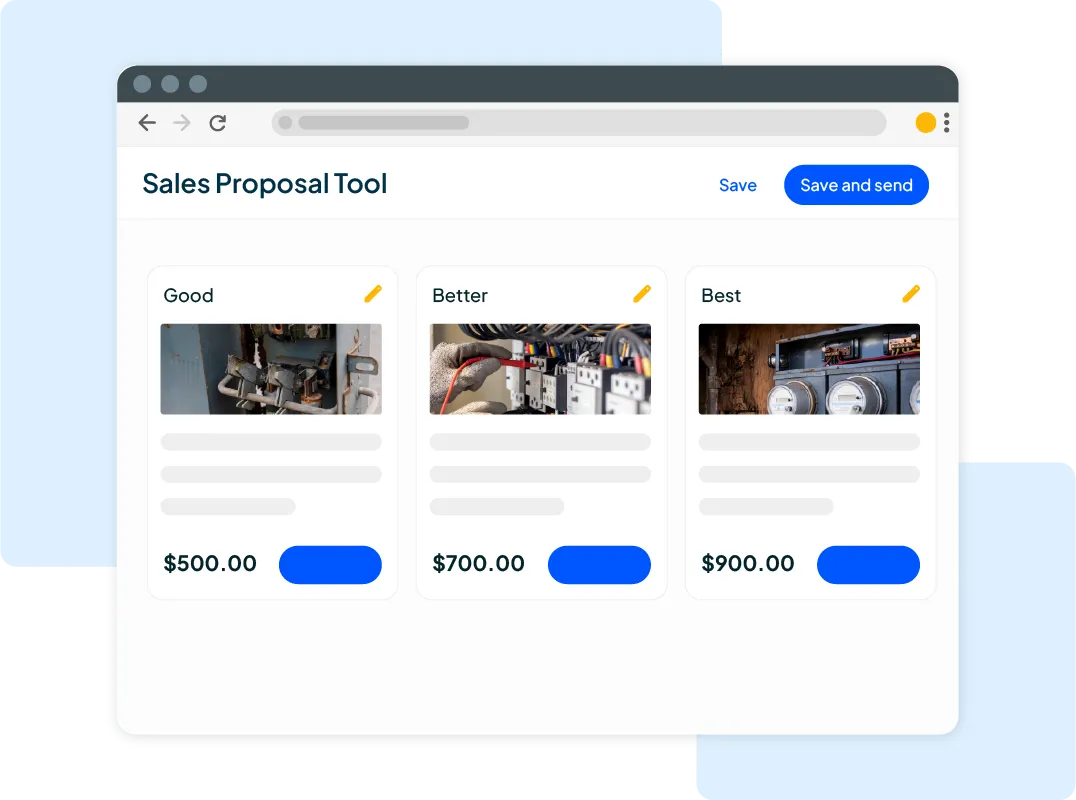Want to win more jobs with less effort?
Grow your business and send quick quotes with our home service software.

Want to see your potential revenue?
See what businesses like yours earn with Housecall Pro in 1 - 2 minutes.

You’ve got the tools, know-how, and drive to run your own handyman business. Now, you need a plan that converts that momentum into real, measurable growth. That’s where a business plan comes in. It helps you set goals, secure funding, and stay on track as you scale.
In this guide, we’ll explain how to write a handyman business plan step by step. You can also download our free handyman business plan template to get started.
Pro tip: Bring both your full business plan and a one-page summary when meeting investors or lenders.
Key takeaways
Here’s a quick summary of how to write a handyman business plan:
Set clear goals: Define growth milestones, revenue targets, and long-term vision.
Outline your services: Detail offerings, niches, and recurring contracts to show value.
Plan operations: Map workflows, scheduling, tools, and software for smooth daily management.
Develop pricing strategy: Set profitable rates, track costs, and plan for adjustments over time.
Know your market: Research local demand, competitors, and target customers to guide decisions.
Prepare finances and growth plans: Include expenses, revenue projections, staffing, and supporting documents for lenders or partners.
What to include in your handyman business plan
Every business plan follows the same basic form, but your handyman plan needs to reflect how you really work in the field. Here’s what it should include:
- Step 1: Cover page and table of contents
- Step 2: Executive summary
- Step 3: Business overview
- Step 4: Management team
- Step 5: Handyman services list
- Step 6: Operations plan
- Step 7: Handyman pricing
- Step 8: Industry analysis
- Step 9: Marketing strategy
- Step 10: Employee planning
- Step 11: Financial planning
- Step 12: Appendix
- How Housecall Pro can help you grow your handyman business
Step 1: Cover page and table of contents
Kick things off with a clean, professional cover page. This is what lenders, partners, and investors see right off the bat, so keep it simple and nicely organized. Add your handyman company’s name, logo, and contact details. Pop in the date you finished the plan or when you last updated it. If you already have a brand identity (company colors, fonts, or a tagline), carry that through here for a consistent look.
Right after your cover page, add a table of contents. It helps readers find the sections that matter most fast, like financials or market research. A clear layout makes your business look polished and shows you’ve thought through every part of your business plan.
Pro tip: Use Housecall Pro to save branded materials—like your logo, cover page, and estimates—in one place so everything looks professional and consistent.
Step 2: Executive summary
Your executive summary gives a snapshot of your handyman business at a glance. It’ll outline what your company does, who you serve, and what makes you different from your competitors. Think of it as your business’s short story: the part of your plan that convinces investors, lenders, or could-be partners that your business is worth their time and attention.
Keep this section brief (one page at most). Stick with a few highlights:
- Business overview: What services you offer and where you operate
- Mission statement: What drives your company, and how you define success
- Goals: Short- and long-term milestones, such as revenue goals, staffing plans, or expansion into different service areas
- Competitive advantage: What gives you an edge, like same-day service, recurring service packages, or a strong online presence
The best summaries get to the point, staying clear and specific. Show confidence in your numbers, communicate your expertise, and give readers a reason to believe your handyman business is set up for success.
Pro tip: When listing goals, show a concrete milestone: “Reach $10K/month in revenue within 12 months with a two-person crew.”
Step 3: Business overview
Your business overview comes next. It’ll explain how your company is structured and what it looks like in action. It draws the foundation of your business: how it operates, who owns it, and where it services customers. This part gives readers a solid understanding of your setup and shows that your business is ready to hit the ground running from day one.
It should include these details:
- Your business name and structure (sole proprietor, LLC, partnership, corporation)
- All owners and their percentage of ownership or roles
- Where your business is based and which areas you cover
- Your state handyman license (if your state requires one), liability insurance, and specialty certifications (if applicable)
If your company is already established, include a brief history here, too. It should cover when you started, how the business has grown, and what types of clients you usually serve. For instance, you might note that you serve the greater Dallas-Fort Worth area and focus on older homes that often need repairs.
If you’re a new handyman business, share why you’re starting now and what opportunity you see in your market, such as identifying a gap in same-day repair services or offering specialized seasonal maintenance packages that aren’t widely available in your area.
Step 4: Management team
Here, you’ll focus on the team who keep things moving. List each owner or manager by name and role, followed by a short summary of their experience and expertise. Touch on what each person brings to the table, like leadership skills, technical certifications, or years in the field. For example, you might note who oversees daily operations, handles finances, manages sales, or leads field teams.
If you’re a newer business or single-owner operation, highlight your professional background and how it positions you for success. Lenders and partners want to see you have the right mix of hands-on trade experience and business management skills to grow confidently.
Step 5: Handyman services list
Your business plan should definitively outline your service offerings and the customers you serve. This will give readers a better idea of your capabilities and lay the foundation for pricing and marketing later on. It might include:
- General home services
- Fixture replacements
- Drywall patching
- Minor plumbing work
- Carpentry projects
- Seasonal “home checkup” packages or annual repair bundles
Build from there, adding specialty offerings that make your company stand out. That might include tile repairs, accessibility upgrades, or minor electrical work that fits within your licensing requirements. If you plan to offer recurring service contracts (think quarterly walk-throughs to check things like gutters, weatherstripping, and smoke detectors), describe what they include and how they’ll support recurring revenue.
Be specific about who you serve—residential clients, commercial, or both. Call out any niches, like property management or supporting real estate agents with pre-listing repairs. The more clearly you define your services now, the easier it’ll be to align your pricing, staffing, and marketing down the line.
Learn more: 20+ Handyman Services to Offer Clients
Step 6: Operations plan
Your operations plan explains how your business will run day-to-day. It should show that you’ve thought through your workflow, scheduling, and tools. Make sure to outline:
- How you’ll handle scheduling, job requests, and customer communication
- Your material and hardware suppliers
- How you plan to manage vehicles, tools, and materials
- Any software you use to simplify your workflow, like Housecall Pro for dispatching, invoicing, and payments.
Keep this part focused on systems, not just tasks. A well-defined plan for managing time and resources shows lenders and partners you’re ready to scale.
Get In Touch: 858-842-5746
Let us earn your trust
On average, Pros increase monthly revenue generated through Housecall Pro by more than 35% after their first year.
See plan options and feature breakdown on our pricing page.
Step 7: Handyman pricing
Your pricing shapes both your profitability and your customers’ perception of value. Here, you’ll debrief on how you set your rates and verify that every repair or project stays profitable.
Outline your approach, including your pricing strategy, be it flat-rate, hourly, or project-based. Include how you calculate margins for labor, materials, and overhead. This might be as simple as citing Housecall Pro’s Price Book and Job Costing features, which make it easy to track expenses, compare estimates to actuals, and keep your pricing consistent across the board.
Add a brief note about how you plan to adjust pricing over time, such as annual rate reviews or cost-of-materials updates. This shows you have a good grasp of the financial side of running a stable, long-term handyman business.
Step 8: Industry analysis
Your industry analysis is what shows you understand the handyman market and where your business fits within it. It should review the demand in your area, any seasonal patterns or repair trends you see locally, and any potential growth opportunities you plan to go after.
Pinpoint your intended demographic here. That might be homeowners in older properties or property managers handling commercial spaces. Then, define what those customers want most: quick response times, transparent pricing, or recurring maintenance options.
Provide a brief look at your primary competitors, too. Note their strengths and where your business stands out, such as through faster response times or better online reviews (if you’re already established). A clear picture of your market helps you make smarter calls about where you’ll go with your business.
Stay in the loop: Sign up for the TradeWire newsletter to get trends, tools, and trade talk straight to your inbox.
Step 9: Marketing strategy
Your handyman marketing strategy covers how you’ll bring in new customers and keep your schedule full year-round. Detail the channels you’ll use to reach homeowners and local businesses, including online platforms, community outreach, and referral programs.
Include specifics on your branding and online presence, such as your website, Google Business Profile, and customer review strategy. Describe any planned promotions, referral incentives, or content efforts that will help maintain visibility and encourage repeat business. This section should clearly show how your marketing efforts support growth and help you stand out in your service area.
Step 10: Employee planning
This part outlines your current staffing setup and how you’ll expand your crew as demand increases. Note your core roles—handymen, helpers, office staff—and who’s handling what. Then, describe your hiring plan. Include when you’ll bring on additional handymen or apprentices (it doesn’t have to be exact). If you require specific certifications, safety training, or trade specialties, call those out to show how you’ll maintain consistent, high-quality work.
If you’re a solo operator, explain how you’ll manage all roles yourself initially and under what conditions you’d hire help. For instance, you might handle all tasks alone until weekly jobs exceed 15, then hire a part-time helper. This demonstrates foresight and shows investors or lenders that you have a plan for growth without sacrificing efficiency or service quality.
Step 11: Financial planning
Financial planning is all about turning your goals into clear, measurable numbers. It signals to lenders and partners that you’ve got a solid grasp of your costs, revenue potential, and growth plans.
List your expenses: Tools, vehicles, licensing, insurance, marketing. Then, estimate your monthly operating costs. That includes payroll, materials, and software. From there, move on to revenue projections based on average repair or project cost and expected number of jobs per week.
Add a simple profit-and-loss statement or cash flow forecast to visualize your break-even point.
Step 12: Appendix
The appendix is where you include supporting documents that back up your business plan. Look at it as your reference folder. It’s full of the things a lender or investor may want to take a closer look at.
It should include copies of your handyman license, insurance certificates, and core permits. It’s also a good place to include resumes for owners or managers, supplier agreements, or equipment lists. If you’ve already created branded assets like estimates or invoices in Housecall Pro, adding samples can help show that your business is set up for professional, organized operations from the start.
Keep this section straightforward and easy to browse. A clear appendix makes your plan feel complete without smothering the reader with excessive detail.
How Housecall Pro can help you grow your handyman business
Technical skill keeps your work quality high. The right systems keep your business running like a well-oiled machine. Housecall Pro gives you all the tools you need to run and grow your handyman company in one place.
With Housecall Pro’s handyman software, you can:
- Build accurate estimates and send professional quotes in minutes.
- Stay profitable on every job by tracking labor, materials, and margins in real-time.
- Keep pricing consistent by managing and updating rates across all services.
- Stay connected to customers via email and postcard promotions, automatable through Campaigns.
- Fill your schedule automatically by letting homeowners book jobs 24/7 with Online Booking.
- Make smarter business decisions by keeping an eye on performance and growth through Advanced Reporting.
Each aspect works together to save you time, improve accuracy, and help you scale your handyman business confidently. Start building your business with the same assurance you bring to every job. Try Housecall Pro for free for 14 days.
FAQ
-
Is a handyman business profitable?
-
Yes, a handyman business can be highly profitable. Because overhead is relatively low—a work vehicle, basic tools, insurance, and a simple business setup are essentially all you need to start—most handymen earn a solid income.
-
What is the best business structure for a handyman?
-
The best business structure for a handyman is usually an LLC, though some choose a sole proprietorship when starting out. LLCs offer better personal liability protection and are excellent for companies that handle a wide variety of home repairs. Sole proprietorships, on the other hand, are easy to set up and work well when you’re just getting started.
-
How much money do I need to start a handyman business?
-
The amount of money you’ll need to start a handyman business can range from a few hundred dollars to a few thousand dollars, depending on what you already own. You’ll generally need tools, a reliable vehicle, insurance, and basic marketing (like a website and branded business cards). Many new handymen keep costs low by starting with the tools they have and adding more as the business grows.







